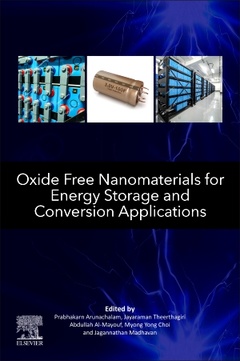Description
Oxide Free Nanomaterials for Energy Storage and Conversion Applications
Coordinators: Arunachalam Prabhakarn, Theerthagiri Jayaraman, Al-Mayouf Abdullah, Yong Choi Myong, Jagannathan Madhavan
Language: English
Subject for Oxide Free Nanomaterials for Energy Storage and...:
492 p. · 15.2x22.8 cm · Paperback
Description
/li>Contents
/li>Biography
/li>Comment
/li>
Oxide Free Nanomaterials for Energy Storage and Conversion Applications covers in depth topics on non-oxide nanomaterials involving transition metal nitrides, carbides, selenides, phosphides, oxynitrides based electrodes, & other non-oxide groups. The current application of nanostructured nonoxides involves their major usage in energy storage and conversion devices variety of applications such as supercapacitor, batteries, dye-sensitized solar cells and hydrogen production applications. The current application of energy storage devices involves their usage of nanostructured non-oxide materials with improved energy and power densities. In this book readers will discover the major advancements in this field during the past decades. The various techniques used to prepare environmentally friendly nanostructured non-oxide materials, their structural and morphological characterization, their improved mechanical and material properties, and finally, current applications and future impacts of these materials are discussed.
While planning and fabricating non-oxide materials, the readers must be concern over that they ought to be abundant, cost-efficient and environment-friendly for clean innovation and conceivably be of use in an expansive choice of utilization. The book gives detailed literature on the development of nanostructured non-oxides, their use as energy related devices and their present trend in the industry and market.
This book also emphasis on the latest advancement about application of these noble non-oxide based materials for photocatalytic water-splitting. Recent progress on various kinds of both photocatalytic and electrocatalytic nanomaterials is reviewed, and essential aspects which govern catalytic behaviours and the corresponding stability are discussed.
The book will give an updated literature on the synthesis, potential applications and future of nanostructured non-oxides in energy related applications. This book is highly useful to researchers working in the field with diversified backgrounds are expected to making the chapter truly interdisciplinary in nature. The contents in the book will emphasize the recent advances in interdisciplinary research on processing, morphology, structure and properties of nanostructured non-materials and their applications in energy applications such as supercapacitors, batteries, solar cells, electrochemical water splitting and other energy applications. Thus, nanotechnology researchers, scientists and experts need to have update of the growing trends and applications in the field of science and technology. Further, the postgraduate students, scientists, researchers and technologists are need to buy this book.
Part 1: Introduction 1. Nanostructured oxide-free nanomaterials -an introduction 2. General methods of synthesis of nanostructured oxide-free materials 3. Fundamentals, basic components and performance evaluation of energy storage and conversion devices
Part 2: Energy storage 4. Oxides free materials for symmetric capacitor 5. Oxides free materials for asymmetric capacitor 6. Oxides free materials for flexible and paper-based supercapacitors 7. Oxides free materials as anodes for lithium ion batteries 8. Oxides free materials as anodes for sodium ion batteries 9. Oxides free materials as anodes for zinc bromine batteries
Part 3: Energy Conversion 10. Metal nitrides and carbides as advanced counter electrodes for dye sensitized solar cells 11. Metal chalcogenide-based counter electrodes for dye-sensitized solar cells 12. Oxides free materials for perovskite solar cells 13. Multi-junction solar cells based on III/V and II/VI semiconductors 14. Oxides free materials for electrochemical water splitting 15. Oxides free materials for photoelectrochemical water splitting 16. Oxides free materials for photocatalytic water splitting 17. Oxide free materials for thermoelectric and pizo-electric applications
Part 4: Summary and Outlook 18. Future prospects of oxide-free materials for energy related applications
Dr. Theerthagiri Jayaraman is a Brain Pool Fellow in the Department of Chemistry, Gyeongsang National University, South Korea, since August 2019. He worked as a Scientist-C/Assistant Professor in the Centre of Excellence for Energy Research, Centre for Nanoscience and Nanotechnology Sathyabama Institute of Science and Technology, Chennai, India, from May-2017 to July-2019. He received his B.Sc Degree in Chemistry from Sacred Heart College in 2009 and M.Sc Degree in Chemistry from Ramakrishna Mission Vivekananda College in 2011. He completed his Ph.D. Degree in the Department of Chemistry, Thiruvalluvar University in March 2017. His current research focuses on developing electrocatalysts for energy applications, Pt-free counter electrode materials for dye-sensitized solar cells, polymer electrolytes, and catalysis for energy and environmental remediations. He has published more than 120 research articles in peer-reviewed journals and 9 book chapters.
Abdullah M. Al-Mayouf is professo
- Offers a comprehensive coverage of the nanostructured non-oxide materials and their potential energy applications
- Examines the properties of nanostructured non-oxide materials that make them so adaptable
- Explores the mechanisms by which nanoparticles interact with each other, showing how these can be used for industrial applications
- Shows the how nanostructured non-oxide materials are used in a wide range of industry sectors, containing energy production and storage




